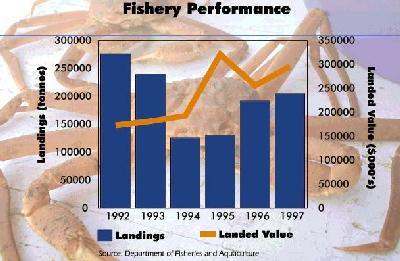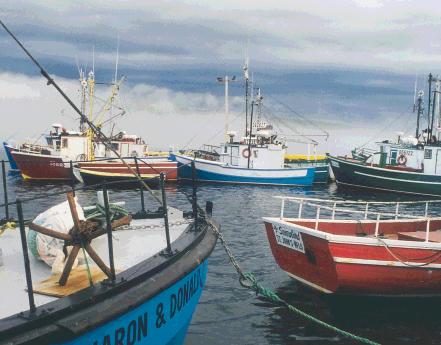 On the strength
of market improvements, the seal fishery posted a solid performance in 1997. Seal harvests
rose 10 percent which, combined with higher prices to fishermen, gave rise to a 32 percent
increase in landed value.
On the strength
of market improvements, the seal fishery posted a solid performance in 1997. Seal harvests
rose 10 percent which, combined with higher prices to fishermen, gave rise to a 32 percent
increase in landed value. The Province's fishing industry has undergone significant restructuring and diversification since the early 1990s. Driven by higher production volumes and prices for some species, the value of landings reached $295 million last year, representing an increase of 16 percent over the previous year. Landings totaled 204,000 tonnes, up 13 percent over 1996. Higher catches of crab and shrimp were the main drivers behind the rise in domestic landings, while some limited commercial activity on the south coast gave rise to an increase in cod landings. Fish imports and aquaculture production, which averaged about 28,000 and 1,600 tonnes respectively, remained fairly stable relative to 1996. Overall, the value of seafood products produced in the Province reached an estimated $575 million, up $33 million from the previous year.
 On the strength
of market improvements, the seal fishery posted a solid performance in 1997. Seal harvests
rose 10 percent which, combined with higher prices to fishermen, gave rise to a 32 percent
increase in landed value.
On the strength
of market improvements, the seal fishery posted a solid performance in 1997. Seal harvests
rose 10 percent which, combined with higher prices to fishermen, gave rise to a 32 percent
increase in landed value.
The overall increase in landings led to higher employment in the processing sector. Employment grew by approximately 20 percent from 1996 to 5,400 on an annual average basis, while aggregate employment in the harvesting sector remained virtually unchanged.
ISSUES
The imposition of moratoria on major groundfish stocks and the associated loss of income for industry workers led the federal government to implement an income replacement program. In its current form, The Atlantic Groundfish Strategy (TAGS) is slated to expire in August 1998. A post-TAGS response is expected to be announced soon, and include, among other things, some measure of income replacement for those still adversely affected by the moratoria.
 Last year the Province announced a new policy framework for the fish
processing sector designed to lead to a more stable, viable and competitive industry. Key
elements included the sector’s development around core/multi-species plants and a
provision for the transfer of processing licences between and within designated regions.
In the long term, these measures are expected to facilitate improved business planning and
investment. This action should lengthen the processing season and extend the employment
period for workers.
Last year the Province announced a new policy framework for the fish
processing sector designed to lead to a more stable, viable and competitive industry. Key
elements included the sector’s development around core/multi-species plants and a
provision for the transfer of processing licences between and within designated regions.
In the long term, these measures are expected to facilitate improved business planning and
investment. This action should lengthen the processing season and extend the employment
period for workers.
As a result of the recent gains in shellfish, many fishermen and processors are making the investment necessary to accommodate emerging fisheries. A detailed list of major capital projects in the fishery, together with capital projects in other sectors, is contained at the end of this report.
OUTLOOK
Fish landings are expected to increase in 1998. The seal fishery, fish imports and aquaculture are all expected to make a solid contribution to the sector. Aquaculture in particular will receive more research and development support through the construction of three new facilities. Crab and cod landings are expected to rise this year, with higher shrimp landings expected to be the main driving force behind an improved fisheries performance. Overall, landings are expected to rise by 10-15 percent in 1998.
| Publicly Traded Company Profiles Fishery Products International (FPI) is a global seafood company with a significant presence in Newfoundland. In the year ahead, FPI is expected to continue with diversification efforts as it proceeds with the conversion of two existing groundfish plants into shellfish plants. FPI recorded a net income of $8.2 million last year, a 34 percent increase from 1996, on revenue of $675.9 million. National Sea Products Limited (NSP) operates a fish processing facility in the Province concentrating on local and imported groundfish, surf clams, and herring. Over the last fiscal year, NSP recorded a net income of $8.6 million, a 146 percent increase from 1996, on revenue of $277 million. |
Main Page Contents Previous Next